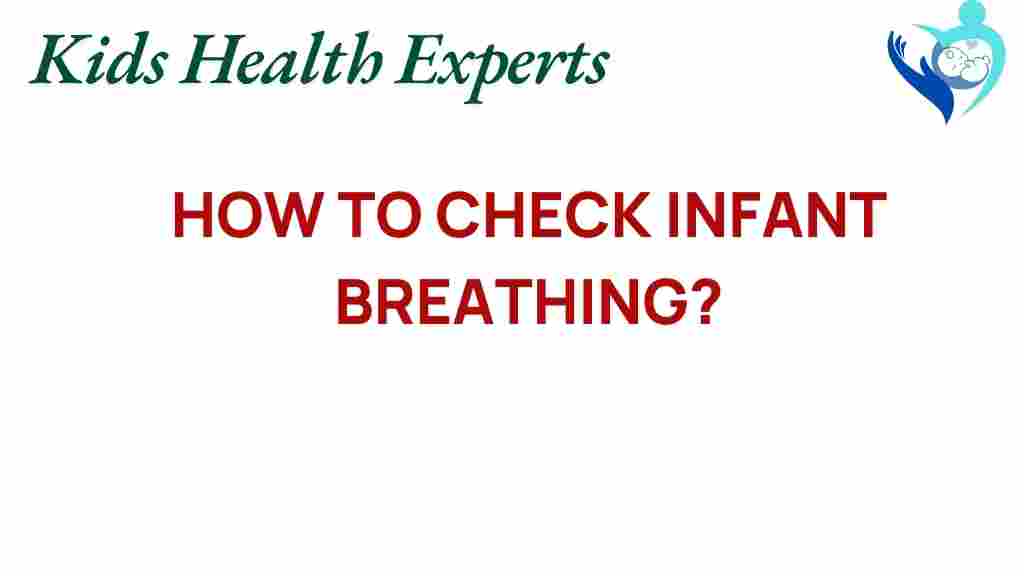Unveiling the Secrets: How to Check Infant Breathing Effectively
As a new parent, one of the most essential aspects of newborn care is ensuring your infant’s safety and health, especially when it comes to their respiratory health. Understanding how to monitor infant breathing can provide peace of mind and allow you to act quickly if any issues arise. This article will guide you through effective methods to check your infant’s breathing, signs of distress to look for, and best practices for maintaining a safe sleep environment.
Understanding Infant Breathing
Infants have unique breathing patterns that differ significantly from those of older children and adults. Here are some key points to understand:
- Infants typically breathe faster than adults, with an average rate of 30-60 breaths per minute.
- Their breathing can be irregular, with periods of rapid breaths followed by slower ones.
- Normal breathing sounds may include soft whistling or gurgling, especially during sleep.
Why Monitoring Infant Breathing is Critical
Monitoring your baby’s breathing is crucial for several reasons:
- It helps identify any potential health issues early on.
- It ensures your baby is getting adequate oxygen.
- It provides reassurance to parents, reducing anxiety about their child’s well-being.
Steps for Checking Infant Breathing Effectively
To ensure your infant is breathing properly, follow these steps:
1. Create a Calm Environment
Before checking your baby’s breathing, ensure the room is calm and quiet. This will help both you and your baby feel relaxed.
2. Position Your Infant
Lay your baby on their back on a firm, flat surface, like a crib or changing table. This position is crucial for safe sleep and allows for easy observation of their breathing.
3. Observe the Chest Movement
Watch your infant’s chest for rising and falling movements. Pay attention to:
- Symmetrical movements: Both sides of the chest should rise and fall evenly.
- Rate of breathing: Count the number of breaths for one minute.
4. Listen to Breathing Sounds
Gently place your ear near your infant’s mouth and nose to listen for sounds. Normal breathing should be:
- Soft and quiet, without wheezing or stridor.
- Regular, with no pauses longer than 20 seconds.
5. Check for Signs of Distress
Be vigilant for signs of distress, which may include:
- Rapid or shallow breathing.
- Grunting sounds or noticeable effort to breathe.
- Flared nostrils or retractions (pulling in of the skin around the ribs).
- Unusual skin color (blue or gray tint).
6. Use Baby Monitoring Devices
Consider using baby monitors designed to track infant breathing and alert you to any irregularities. This technology can provide an extra layer of safety when you are not in the same room as your baby.
Maintaining a Safe Sleep Environment
Creating a safe sleep environment is vital for your infant’s health. Follow these guidelines:
- Always place your baby on their back to sleep.
- Use a firm mattress with a fitted sheet, avoiding soft bedding, pillows, or toys.
- Keep the crib free from items that could pose a suffocation risk.
- Maintain a comfortable room temperature to prevent overheating.
Troubleshooting Common Concerns
If you notice anything unusual during your checks, consider these troubleshooting tips:
1. Irregular Breathing Patterns
It is common for infants to have irregular breathing patterns, especially during sleep. However, if you notice:
- Periods of apnea lasting more than 20 seconds.
- Consistently rapid or labored breathing.
Consult your pediatrician for further evaluation.
2. Signs of Illness
If your baby exhibits any of the following signs, contact a healthcare professional immediately:
- Persistent coughing or wheezing.
- Fever above 100.4°F (38°C).
- Difficulty feeding due to breathing issues.
3. Sudden Changes in Behavior
A sudden change in your baby’s behavior, such as excessive fussiness or lethargy, may indicate a health issue. If you observe these changes, seek medical advice.
Parental Guidance: When to Seek Help
As a parent, knowing when to seek help is crucial for your infant’s safety. If you are ever in doubt about your baby’s breathing or overall health, do not hesitate to reach out to a healthcare professional. It’s always better to be cautious and get a second opinion.
Conclusion
Monitoring infant breathing is a vital skill for every new parent. By following the steps outlined in this article, you can effectively check your baby’s respiratory health and identify any signs of distress. Always prioritize your infant’s safety by creating a safe sleep environment and being vigilant for any health changes. Remember, you are not alone in this journey; seek support and guidance whenever needed. For more information on newborn care, check out this helpful resource. Additionally, for more insights into safe sleep practices, visit this external link. Your infant’s health and well-being are paramount, and with the right knowledge and tools, you can ensure they thrive.
This article is in the category Care and created by KidsHealthExperts Team
